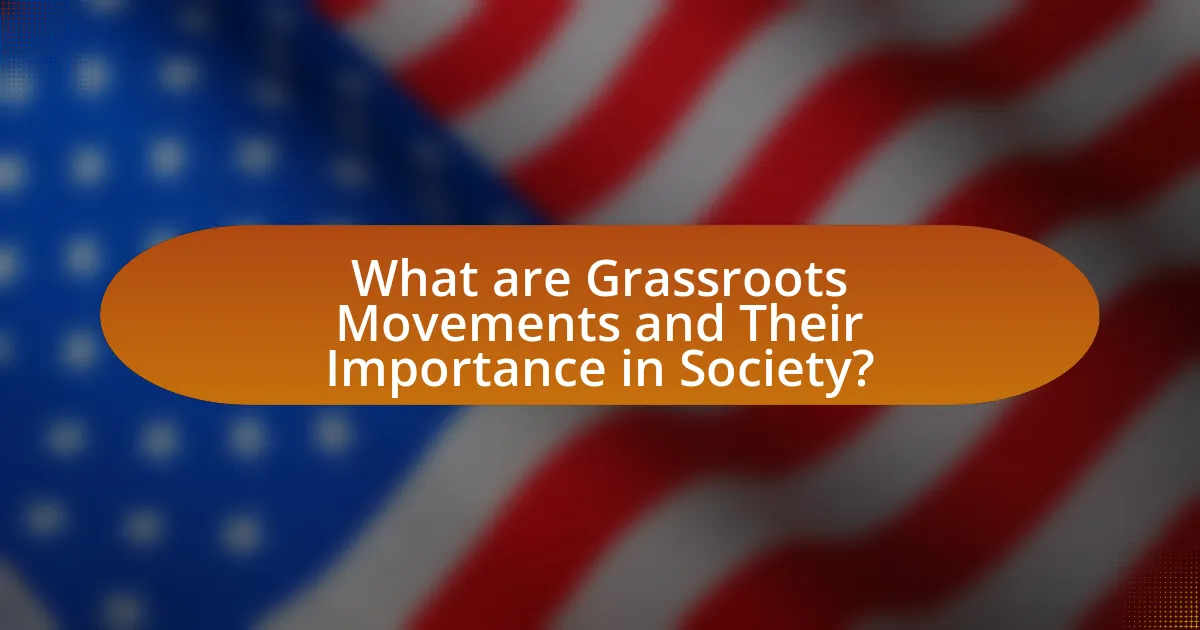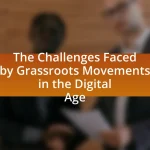Grassroots movements are organized efforts by ordinary people aimed at achieving social or political change, emerging primarily from local communities. This article explores the significance of grassroots movements in society, highlighting their role in empowering individuals, influencing policy, and addressing local issues. It examines the differences between grassroots and traditional movements, their key characteristics, and the essential role they play in community engagement, particularly during and after the COVID-19 pandemic. Additionally, the article discusses the challenges these movements face, strategies for sustaining momentum, and the impact of technology on their evolution, providing insights into future trends and best practices for effective grassroots activism.

What are Grassroots Movements and Their Importance in Society?
Grassroots movements are organized efforts by ordinary people to effect social or political change, often emerging from local communities. These movements are important in society because they empower individuals to advocate for their rights, influence policy, and address issues that directly affect their lives. For instance, the Civil Rights Movement in the United States, which began at the grassroots level, successfully challenged systemic racism and led to significant legislative changes, such as the Civil Rights Act of 1964. This demonstrates how grassroots movements can mobilize collective action, raise awareness, and create lasting societal impact.
How do Grassroots Movements differ from Traditional Movements?
Grassroots movements differ from traditional movements primarily in their structure and origin, with grassroots movements emerging from local communities and relying on collective action, while traditional movements often have centralized leadership and formal organizations. Grassroots movements prioritize bottom-up participation, allowing individuals to mobilize around shared issues without hierarchical constraints, as seen in movements like Black Lives Matter, which gained traction through social media and community engagement. In contrast, traditional movements, such as labor unions, typically operate within established frameworks and often seek to influence policy through formal channels. This distinction highlights the adaptability and immediacy of grassroots movements in responding to contemporary social issues, particularly in a post-pandemic context where local voices are increasingly amplified.
What are the key characteristics of Grassroots Movements?
Grassroots movements are characterized by their community-driven nature, emphasizing local participation and collective action. These movements typically arise from the needs and concerns of ordinary people rather than established institutions, fostering a sense of empowerment and ownership among participants. They often utilize decentralized organizational structures, allowing for flexibility and adaptability in response to changing circumstances. Additionally, grassroots movements leverage social networks and digital platforms to mobilize support and spread awareness, as seen in movements like Black Lives Matter and climate activism. Their effectiveness is often rooted in their ability to engage diverse groups and create inclusive dialogues, which enhances their legitimacy and impact.
Why are Grassroots Movements essential for community engagement?
Grassroots movements are essential for community engagement because they empower individuals to collectively address local issues and influence decision-making processes. These movements foster a sense of ownership and responsibility among community members, leading to increased participation in civic activities. For instance, research by the Stanford Social Innovation Review highlights that grassroots initiatives often mobilize diverse groups, enhancing social capital and fostering collaboration. This engagement is crucial in a post-pandemic world, where communities face unique challenges and require collective action to rebuild and thrive.
What role did Grassroots Movements play during the Pandemic?
Grassroots movements played a crucial role during the pandemic by mobilizing communities to address immediate needs and advocate for social justice. These movements organized mutual aid networks, providing food, medical supplies, and support to vulnerable populations, which was essential as traditional systems struggled to respond effectively. For instance, organizations like the COVID-19 Mutual Aid Network emerged, facilitating local responses and fostering community resilience. Additionally, grassroots movements highlighted systemic inequalities, pushing for policy changes related to healthcare access and economic support, as seen in protests advocating for equitable vaccine distribution. Their efforts not only addressed urgent needs but also laid the groundwork for ongoing advocacy in a post-pandemic world.
How did Grassroots Movements adapt to the challenges posed by the Pandemic?
Grassroots movements adapted to the challenges posed by the pandemic by leveraging digital platforms for organization and communication. As in-person gatherings were restricted, these movements shifted to online tools such as social media, video conferencing, and virtual events to mobilize supporters and disseminate information. For instance, the Black Lives Matter movement utilized social media to coordinate protests and raise awareness, demonstrating the effectiveness of digital engagement during lockdowns. Additionally, many grassroots organizations focused on mutual aid initiatives, providing essential services like food distribution and health resources to vulnerable communities, which highlighted their adaptability and resilience in crisis situations.
What successes did Grassroots Movements achieve during this time?
Grassroots movements achieved significant successes during this time by mobilizing communities to advocate for social justice, environmental protection, and public health reforms. For instance, the Black Lives Matter movement gained global traction, leading to policy changes in police practices and increased awareness of systemic racism. Additionally, grassroots organizations played a crucial role in promoting vaccination campaigns and public health measures during the COVID-19 pandemic, resulting in higher vaccination rates in underserved communities. These movements demonstrated the power of collective action, as evidenced by the millions of participants in protests and advocacy efforts, which influenced public discourse and policy decisions.
What are the potential future trends for Grassroots Movements post-Pandemic?
Grassroots movements are likely to increasingly leverage digital platforms for organization and mobilization in the post-pandemic era. The COVID-19 pandemic accelerated the adoption of technology for communication and activism, leading to a rise in online campaigns and virtual events. According to a report by the Pew Research Center, 53% of Americans engaged in activism online during the pandemic, indicating a shift towards digital engagement that is expected to persist. Additionally, there is a growing emphasis on intersectionality within these movements, as activists seek to address multiple social justice issues simultaneously, reflecting a more holistic approach to advocacy. This trend is supported by the increased collaboration among diverse groups, as seen in movements like Black Lives Matter, which gained momentum through both in-person protests and online activism.
How might technology influence the evolution of Grassroots Movements?
Technology significantly influences the evolution of grassroots movements by enhancing communication, mobilization, and organization. Digital platforms enable rapid dissemination of information, allowing grassroots organizations to reach wider audiences quickly. For instance, social media has been pivotal in movements like Black Lives Matter, where platforms facilitated real-time updates and coordinated protests, demonstrating the power of technology in amplifying voices and fostering community engagement. Additionally, tools such as crowdfunding and online petitions have transformed fundraising and support mechanisms, making it easier for grassroots initiatives to gain financial backing and public support. The integration of technology thus reshapes the landscape of grassroots activism, making it more accessible and impactful in addressing social issues.
What new strategies could emerge for mobilizing communities?
New strategies for mobilizing communities may include leveraging digital platforms for grassroots organizing and utilizing data analytics to identify community needs. Digital platforms, such as social media and community apps, facilitate real-time communication and engagement, allowing for rapid mobilization around issues. For instance, during the COVID-19 pandemic, organizations like Mutual Aid groups effectively used social media to coordinate support for vulnerable populations, demonstrating the power of digital tools in community mobilization. Data analytics can help identify specific community challenges and preferences, enabling targeted outreach and resource allocation. This approach has been validated by studies showing that data-driven strategies enhance engagement and responsiveness in community initiatives.

How can Grassroots Movements sustain momentum in a Post-Pandemic World?
Grassroots movements can sustain momentum in a post-pandemic world by leveraging digital platforms for organization and outreach. The shift to online communication during the pandemic has shown that social media and digital tools can effectively mobilize supporters, share information, and coordinate actions. For instance, movements like Black Lives Matter utilized platforms such as Twitter and Instagram to amplify their messages and engage a global audience, resulting in significant participation and awareness. Additionally, maintaining community engagement through local events and collaborations can reinforce connections and foster a sense of belonging among supporters. Research indicates that sustained engagement leads to increased activism, as seen in the rise of environmental movements post-pandemic, where local initiatives have gained traction through community-driven efforts.
What challenges do Grassroots Movements face in the current landscape?
Grassroots movements face significant challenges in the current landscape, including funding limitations, digital misinformation, and political repression. Funding limitations hinder their ability to sustain operations and outreach, as many rely on small donations and volunteer efforts. Digital misinformation complicates their messaging and can undermine public support, particularly when false narratives spread rapidly on social media platforms. Political repression, including surveillance and legal restrictions, poses a direct threat to their activities and can lead to the criminalization of dissent. These challenges are exacerbated by the ongoing effects of the COVID-19 pandemic, which has shifted public attention and resources away from grassroots initiatives.
How can Grassroots Movements overcome funding and resource limitations?
Grassroots movements can overcome funding and resource limitations by leveraging community engagement and utilizing digital platforms for fundraising. Community engagement fosters local support, which can lead to increased volunteer participation and in-kind donations, reducing reliance on external funding sources. For instance, successful campaigns like the Ice Bucket Challenge raised over $115 million for ALS research through social media, demonstrating the power of grassroots mobilization. Additionally, utilizing crowdfunding platforms allows grassroots movements to reach a wider audience, enabling them to gather small contributions from many supporters, thus diversifying their funding sources. This approach not only mitigates financial constraints but also builds a strong community network that can sustain the movement over time.
What role does community support play in sustaining these movements?
Community support is essential for sustaining grassroots movements as it provides the necessary resources, motivation, and collective action needed for long-term impact. When individuals within a community actively engage in supporting a movement, they contribute to a shared sense of purpose and solidarity, which enhances the movement’s visibility and effectiveness. For instance, research by the Stanford Social Innovation Review highlights that grassroots movements with strong community backing are more likely to achieve their goals, as they can mobilize larger groups, secure funding, and create networks of advocacy. This interconnectedness fosters resilience, allowing movements to adapt and thrive even in challenging circumstances, such as those presented in a post-pandemic world.
How can collaboration enhance the effectiveness of Grassroots Movements?
Collaboration enhances the effectiveness of grassroots movements by pooling resources, skills, and networks, which increases their reach and impact. When diverse groups unite, they can share knowledge and strategies, leading to more innovative solutions to social issues. For instance, the Black Lives Matter movement effectively utilized collaboration with various organizations to amplify its message and mobilize supporters, resulting in widespread protests and policy discussions. This collective action not only strengthens the movement’s voice but also fosters a sense of community and shared purpose, making it more resilient and adaptable in the face of challenges.
What partnerships are most beneficial for Grassroots Movements?
Collaborations with local organizations, non-profits, and community leaders are the most beneficial partnerships for grassroots movements. These partnerships enhance resource sharing, amplify voices, and foster community engagement. For instance, local non-profits often have established networks and trust within the community, which can significantly increase the reach and impact of grassroots initiatives. Additionally, partnerships with advocacy groups can provide strategic support and expertise, enabling grassroots movements to navigate complex political landscapes effectively. Historical examples, such as the Civil Rights Movement, demonstrate that alliances with established organizations can lead to significant social change, showcasing the effectiveness of these partnerships in mobilizing communities and achieving common goals.
How can Grassroots Movements leverage existing networks for greater impact?
Grassroots movements can leverage existing networks by forming strategic alliances with established organizations and utilizing social media platforms for outreach. By collaborating with NGOs, community groups, and local leaders, grassroots movements can tap into pre-existing resources, knowledge, and support systems, enhancing their visibility and credibility. For instance, during the Black Lives Matter movement, local chapters effectively utilized social media to mobilize supporters and share information, resulting in widespread participation and increased awareness. This demonstrates that leveraging existing networks can amplify a movement’s message and foster greater community engagement.

What strategies can Grassroots Movements implement for future success?
Grassroots movements can implement strategies such as leveraging digital platforms for outreach, building coalitions with like-minded organizations, and focusing on community engagement to ensure future success. Utilizing digital platforms allows movements to reach a broader audience quickly; for instance, during the COVID-19 pandemic, many organizations saw a significant increase in engagement through social media and online campaigns. Building coalitions enhances resource sharing and amplifies voices, as evidenced by the success of movements like Black Lives Matter, which partnered with various organizations to strengthen their impact. Lastly, prioritizing community engagement fosters trust and participation, which is crucial for sustaining momentum, as seen in local initiatives that effectively mobilized support during crises.
How can Grassroots Movements effectively engage younger generations?
Grassroots movements can effectively engage younger generations by leveraging digital platforms and social media to create interactive and participatory experiences. Research indicates that 90% of young people use social media, making it a crucial tool for outreach and mobilization. By utilizing platforms like Instagram, TikTok, and Twitter, grassroots movements can share compelling narratives, foster community engagement, and encourage activism through relatable content. Additionally, incorporating gamification elements and peer-to-peer networking can enhance participation, as studies show that young individuals are more likely to engage when they feel a sense of belonging and agency in the movement.
What platforms are most effective for reaching younger audiences?
Social media platforms such as Instagram, TikTok, and Snapchat are most effective for reaching younger audiences. These platforms have gained immense popularity among Gen Z and Millennials, with TikTok alone boasting over 1 billion active users as of 2023, primarily consisting of users aged 16 to 24. Instagram, with its visual-centric content, also attracts a significant younger demographic, with 67% of users aged 18-29. Snapchat’s ephemeral content and interactive features resonate well with younger users, making it a preferred choice for engagement. These statistics demonstrate that these platforms are crucial for effectively connecting with younger audiences in grassroots movements.
How can education and awareness campaigns be tailored for youth engagement?
Education and awareness campaigns can be tailored for youth engagement by utilizing digital platforms and interactive content that resonate with their interests. Research indicates that 95% of teenagers have access to smartphones, making social media an effective channel for outreach. Campaigns should incorporate gamification, relatable messaging, and peer-led initiatives to foster a sense of community and ownership among youth. For instance, studies show that campaigns using interactive elements, such as quizzes or challenges, increase participation rates by up to 50%. By aligning campaign strategies with the digital habits and preferences of young people, organizations can enhance engagement and drive meaningful participation in grassroots movements.
What best practices should Grassroots Movements adopt moving forward?
Grassroots movements should adopt digital engagement strategies to enhance outreach and mobilization. Utilizing social media platforms allows for real-time communication and broader audience reach, as evidenced by the success of movements like Black Lives Matter, which effectively used Twitter and Instagram to organize protests and raise awareness. Additionally, fostering community partnerships can amplify impact; for instance, collaborations with local organizations can provide resources and support, as seen in various climate action initiatives. Finally, prioritizing inclusivity ensures diverse voices are represented, which strengthens the movement’s legitimacy and effectiveness, as demonstrated by the varied coalitions formed during the Women’s March.
How can Grassroots Movements measure their impact and success?
Grassroots movements can measure their impact and success through a combination of quantitative metrics and qualitative assessments. Quantitative metrics include tracking membership growth, fundraising totals, and social media engagement, which provide concrete data on the movement’s reach and influence. For instance, a study by the Stanford Social Innovation Review found that movements with increased online engagement saw a 30% rise in participation at events. Qualitative assessments involve gathering testimonials and feedback from participants, which can highlight personal stories of change and community impact. This dual approach allows grassroots movements to present a comprehensive picture of their effectiveness and adapt strategies accordingly.
What are the key elements of a successful Grassroots Movement strategy?
The key elements of a successful grassroots movement strategy include community engagement, clear messaging, and strategic use of social media. Community engagement fosters local support and mobilizes individuals around a common cause, as seen in movements like Black Lives Matter, which effectively organized local chapters to amplify voices. Clear messaging ensures that the movement’s goals are easily understood and resonate with the target audience, exemplified by the Women’s March, which articulated specific demands for gender equality. Strategic use of social media allows for rapid dissemination of information and mobilization of supporters, demonstrated by the Ice Bucket Challenge, which raised awareness and funds for ALS through viral sharing. These elements collectively enhance the effectiveness and reach of grassroots movements.
What practical tips can Grassroots Movements use to thrive in a Post-Pandemic World?
Grassroots movements can thrive in a post-pandemic world by leveraging digital tools for outreach and engagement. The pandemic has accelerated the adoption of technology, allowing movements to connect with wider audiences through social media, virtual meetings, and online campaigns. For instance, according to a report by the Pew Research Center, 53% of Americans engaged with social media for news during the pandemic, highlighting the importance of these platforms for mobilization. Additionally, grassroots movements should focus on building local coalitions to address community-specific issues, as collaboration enhances resource sharing and strengthens community ties. Research from the Stanford Social Innovation Review indicates that collective action is more effective when local organizations unite around common goals. Finally, maintaining flexibility and adaptability in strategies will allow grassroots movements to respond effectively to changing circumstances and community needs, ensuring sustained impact and relevance.


